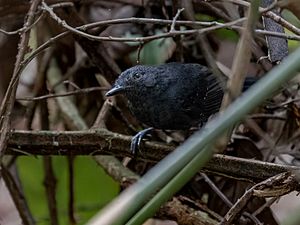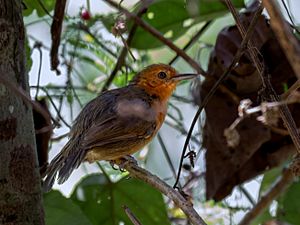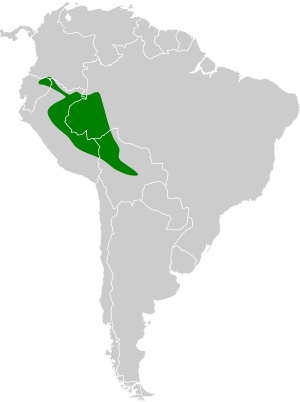Riparian antbird facts for kids
Quick facts for kids Riparian antbird |
|
|---|---|
 |
|
| male at Rio Branco, Acre, Brazil | |
 |
|
| female at same locality | |
| Conservation status | |
| Scientific classification | |
| Genus: |
Cercomacroides
|
| Species: |
fuscicauda
|
 |
|
| Synonyms | |
|
Cercomacra fuscicauda |
|
The riparian antbird (Cercomacroides fuscicauda) is a type of bird found in the Amazon rainforest. It belongs to a group of birds called passerines, which are often known as "perching birds." This means they have feet designed to grip branches. The riparian antbird is part of the Thamnophilidae family, which includes many birds found in Central and South America.
These birds live in specific parts of South America. You can find them in southern Colombia, eastern Ecuador, eastern Peru, northern Bolivia, and the southwestern Amazon region of Brazil.
Contents
Where Riparian Antbirds Live
Riparian antbirds prefer certain kinds of places to live. Their favorite habitats are warm, wet lowland forests. They also like to live near rivers. You can often spot them in thick bushes on sandbars or along riverbanks. The word "riparian" actually means "relating to or situated on the banks of a river." This name perfectly describes where these birds make their homes!
How Scientists Study Birds
For a long time, the riparian antbird was thought to be the same species as the blackish antbird. However, scientists later discovered they were different. They figured this out by listening closely to their calls. The two birds sing very different songs!
Scientists use many methods to understand how living things are related. One important way is called a molecular phylogenetic study. This is a fancy way of saying they look at the DNA of different animals. By studying DNA, scientists can see how closely related species are to each other.
In 2014, a big study like this looked at the Cercomacra group of birds. It turned out that this group wasn't as simple as they thought. Some birds in the group were not as closely related as others.
A New Scientific Name
Because of the DNA study, the Cercomacra group was split into two new groups. This helped scientists organize the birds more accurately. Six species, including the riparian antbird, were moved to a brand new group called Cercomacroides. So, the riparian antbird's full scientific name became Cercomacroides fuscicauda. This change helps scientists and bird watchers better understand the relationships between different bird species.
Images for kids
See also
 In Spanish: Hormiguero ribereño para niños
In Spanish: Hormiguero ribereño para niños



